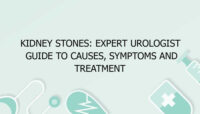Hidradenitis Suppurativa (HS), often referred to as acne inversa, is a chronic skin condition characterized by painful lumps, abscesses, and sometimes scarring. It primarily affects areas of the body where skin rubs together, such as the armpits, groin, buttocks, and under the breasts. Although HS can be debilitating and significantly impact an individual’s quality of life, many people are unaware of its causes, symptoms, and effective treatments. This comprehensive guide aims to provide a clear and human-focused overview of Hidradenitis Suppurativa, helping those affected understand their condition and explore available management options.
Causes of Hidradenitis Suppurativa
The exact cause of Hidradenitis Suppurativa is not fully understood, but it is believed to be linked to a combination of genetic, environmental, and immune factors. HS is not caused by poor hygiene, but rather by blockages in hair follicles, leading to inflammation and the formation of painful nodules or abscesses.
Genetic Factors
Research suggests that genetics play a significant role in the development of HS. Many individuals with the condition have a family history of the disease, indicating a hereditary component. Specific genetic mutations have been identified that may predispose individuals to HS, making it essential for those affected to consider their family health history.
Immune System Dysfunction
An abnormal immune response is also thought to contribute to HS. In people with HS, the immune system may react excessively to normal skin bacteria, leading to chronic inflammation. This immune response can trigger the formation of abscesses and scars, exacerbating the condition.
Environmental Factors
Certain environmental factors can also trigger or worsen Hidradenitis Suppurativa. These may include:
- Friction and Sweating: Areas where skin rubs against skin, such as the inner thighs or armpits, are particularly susceptible to the development of HS.
- Obesity: Excess weight can increase friction and sweating, making HS more likely in those who are overweight.
- Smoking: There is a strong correlation between smoking and HS. Nicotine can impair blood circulation and delay wound healing, worsening the condition.
- Hormonal Changes: Many individuals notice that their symptoms fluctuate with hormonal changes, such as during menstrual cycles, suggesting a hormonal component to the condition.
By understanding these potential causes, individuals can take proactive steps to manage and mitigate their symptoms.
Symptoms of Hidradenitis Suppurativa
The symptoms of Hidradenitis Suppurativa can vary widely among individuals and can range from mild to severe. Common symptoms include:
- Painful Nodules: The initial symptoms often involve small, painful lumps under the skin. These nodules can become inflamed and tender.
- Abscesses: As the condition progresses, nodules may rupture, forming abscesses that can drain pus. This can lead to foul-smelling discharge, causing distress and embarrassment.
- Scarring: Chronic inflammation and repeated abscess formation can result in significant scarring and skin changes in affected areas.
- Sinus Tracts: In more severe cases, HS can create tunnels under the skin called sinus tracts, which can become chronic and lead to further complications.
- Flare-Ups: HS is characterized by episodes or flare-ups where symptoms worsen, often triggered by stress, heat, or certain activities.
Recognizing these symptoms early is crucial for effective management and treatment, allowing individuals to seek help promptly.
Types of Hidradenitis Suppurativa
Hidradenitis Suppurativa can be classified into different types based on the severity and frequency of flare-ups. The two main types include:
1. Mild Hidradenitis Suppurativa
Mild HS typically presents with isolated nodules or abscesses that may resolve without significant intervention. While uncomfortable, the symptoms are usually manageable with good hygiene practices, topical treatments, and lifestyle modifications.
2. Severe Hidradenitis Suppurativa
Severe HS is characterized by multiple inflamed areas, chronic abscesses, and significant scarring. This type may involve the development of sinus tracts and often requires more intensive treatment strategies, including systemic medications and possibly surgical intervention.
Understanding the type of HS an individual has is essential for determining the appropriate course of treatment and management strategies.
Treatment Options for Hidradenitis Suppurativa
Managing Hidradenitis Suppurativa requires a multifaceted approach, often involving lifestyle changes, medications, and in some cases, surgery. Here are some common treatment options:
1. Lifestyle Modifications
Lifestyle changes can significantly impact the severity and frequency of HS flare-ups. Key modifications may include:
- Weight Management: Maintaining a healthy weight can reduce friction in affected areas and decrease the likelihood of flare-ups.
- Smoking Cessation: Quitting smoking can improve overall health and reduce the severity of HS symptoms.
- Hygiene Practices: Regular cleansing and keeping affected areas dry can help prevent infections and reduce irritation.
2. Topical Treatments
For mild cases of HS, topical treatments may be sufficient to manage symptoms. These can include:
- Antibiotic Ointments: Topical antibiotics can help control infection and reduce inflammation.
- Corticosteroid Creams: These can alleviate inflammation and pain during flare-ups.
3. Oral Medications
For moderate to severe cases of HS, oral medications may be necessary. Options include:
- Antibiotics: Long-term antibiotic therapy may be prescribed to control bacterial growth and inflammation.
- Hormonal Treatments: In some cases, hormonal therapies may help regulate flare-ups related to menstrual cycles.
- Immunosuppressants: Medications that suppress the immune system can help reduce inflammation and prevent flare-ups.
4. Biologic Therapies
Biologics are a newer class of medications that target specific pathways in the immune response. Drugs like adalimumab have shown promise in treating moderate to severe HS, reducing the frequency of flare-ups and improving overall skin condition.
5. Surgical Interventions
In cases where medical treatments are ineffective, surgical options may be considered. These can include:
- Incision and Drainage: This procedure may be performed during acute flare-ups to relieve pain and drain abscesses.
- Excision: In more severe cases, surgical excision of affected skin can remove sinus tracts and prevent recurrence.
6. Supportive Care
Supportive care is essential for managing the psychological and emotional aspects of living with HS. This may include counseling, support groups, and educational resources to help individuals cope with the challenges of their condition.
Table: Overview of Hidradenitis Suppurativa
| Aspect | Details |
|---|---|
| Definition | A chronic skin condition characterized by painful lumps, abscesses, and scarring. |
| Causes | Genetic factors, immune dysfunction, environmental triggers (friction, obesity, smoking). |
| Symptoms | Painful nodules, abscesses, scarring, sinus tracts, and flare-ups. |
| Types | Mild HS (isolated nodules) and Severe HS (multiple abscesses, significant scarring). |
| Treatment Options | Lifestyle modifications, topical treatments, oral medications, biologics, surgical interventions. |
Frequently Asked Questions (FAQs)
What is Hidradenitis Suppurativa and how does it differ from acne?
Hidradenitis Suppurativa (HS) is a chronic inflammatory skin condition that primarily affects areas where skin rubs together, such as the armpits, groin, and buttocks. It is characterized by painful lumps, abscesses, and the formation of sinus tracts. While HS is sometimes referred to as “acne inversa,” it is distinct from traditional acne, which typically occurs on the face, chest, and back and is caused by clogged pores. Unlike acne, which is primarily a disorder of the hair follicles, HS involves the skin’s apocrine sweat glands and results from a combination of genetic, hormonal, and environmental factors. Understanding this difference is crucial for appropriate diagnosis and treatment.
What are the common triggers for Hidradenitis Suppurativa?
Hidradenitis Suppurativa can be triggered by various factors, and understanding these can help manage the condition effectively. Common triggers include friction and sweating in areas where skin rubs against skin, which can exacerbate symptoms. Other triggers include obesity, which increases friction; smoking, which can worsen inflammation; and hormonal changes, particularly in women during their menstrual cycles. Stress and certain activities that cause excessive sweating can also contribute to flare-ups. Identifying and avoiding these triggers is essential for individuals with HS, as it can lead to fewer episodes and a better quality of life.
How is Hidradenitis Suppurativa diagnosed?
Diagnosing Hidradenitis Suppurativa typically involves a thorough clinical examination and assessment of the patient’s medical history. A dermatologist will look for characteristic symptoms, such as painful lumps, abscesses, and scarring in areas where HS commonly occurs. In some cases, imaging studies may be used to assess the extent of the disease or rule out other conditions. A biopsy is rarely needed but may be performed if there is uncertainty about the diagnosis. It is essential to provide the healthcare provider with a complete history of symptoms and any triggers to facilitate an accurate diagnosis.
What treatment options are available for Hidradenitis Suppurativa?
Treatment options for Hidradenitis Suppurativa vary depending on the severity of the condition. For mild cases, lifestyle modifications such as
maintaining a healthy weight, practicing good hygiene, and avoiding known triggers can be effective. Topical treatments, including antibiotic ointments and corticosteroid creams, may help alleviate symptoms. For moderate to severe HS, oral medications such as antibiotics, immunosuppressants, and biologics may be prescribed. In cases where medical treatments are insufficient, surgical options like incision and drainage or excision of affected areas may be necessary. Ongoing support and counseling are also crucial for managing the emotional and psychological aspects of living with HS.
Can Hidradenitis Suppurativa be cured?
Currently, there is no definitive cure for Hidradenitis Suppurativa. However, many treatment options can effectively manage symptoms and reduce the frequency of flare-ups. The goal of treatment is to control inflammation, manage pain, and improve the quality of life for individuals affected by HS. Many people find that with appropriate management, they can lead fulfilling lives despite their condition. Ongoing research into new treatments, including biologic therapies and gene therapy, offers hope for more effective management strategies in the future.
What are the psychological impacts of Hidradenitis Suppurativa?
Living with Hidradenitis Suppurativa can significantly impact an individual’s mental health. The chronic pain, visible lesions, and unpredictability of flare-ups can lead to feelings of embarrassment, anxiety, and depression. Many individuals report feeling isolated due to the stigma associated with skin conditions. It is essential to address these psychological impacts through support groups, counseling, and open communication with healthcare providers. Building a support network and finding coping strategies can help individuals manage the emotional toll of HS and improve their overall well-being.
How can lifestyle changes help manage Hidradenitis Suppurativa?
Lifestyle changes play a crucial role in managing Hidradenitis Suppurativa and can help reduce the frequency and severity of flare-ups. Key modifications include maintaining a healthy weight, as excess weight can increase friction and sweating in affected areas. Quitting smoking is another significant change that can improve overall health and reduce inflammation. Practicing good hygiene and keeping affected areas dry can help prevent infections. Additionally, avoiding known triggers, such as tight clothing or heat, can further mitigate flare-ups. By adopting these lifestyle changes, individuals can gain more control over their condition and enhance their quality of life.
Is Hidradenitis Suppurativa contagious?
Hidradenitis Suppurativa is not contagious. It is a chronic inflammatory condition that results from a combination of genetic, environmental, and immune factors, rather than an infectious process. Individuals cannot spread HS to others through skin contact or any other means. This is an important distinction that can help reduce the stigma associated with the condition. Understanding that HS is a non-contagious condition allows those affected to feel more comfortable discussing their experiences and seeking the help they need without fear of judgment.
What research is currently being conducted on Hidradenitis Suppurativa?
Ongoing research into Hidradenitis Suppurativa is focused on better understanding the underlying causes of the condition and developing new treatment options. Studies are exploring the genetic and immunological aspects of HS, aiming to identify specific biomarkers that could lead to more targeted therapies. Researchers are also investigating the efficacy of novel treatments, including biologic therapies that target specific pathways involved in inflammation. Additionally, clinical trials are evaluating the long-term effectiveness of various management strategies, including lifestyle interventions and surgical options. This research is vital for improving the quality of care and outcomes for individuals living with HS.
What support resources are available for individuals with Hidradenitis Suppurativa?
Numerous support resources are available for individuals with Hidradenitis Suppurativa and their families. Organizations such as the Hidradenitis Suppurativa Foundation provide valuable information, educational materials, and support networks for patients. Online forums and support groups offer a platform for individuals to share experiences, advice, and emotional support. Healthcare providers can also connect patients with counselors and mental health professionals to address the psychological aspects of living with HS. These support resources are crucial for enhancing the quality of life for those affected by this chronic condition.
Medical Journals on Hidradenitis Suppurativa
Here are ten notable medical journals that discuss various aspects of Hidradenitis Suppurativa:
| Title | Authors |
|---|---|
| “Hidradenitis Suppurativa: A Review of the Pathophysiology and Treatment” | J. M. Smith, A. R. Johnson |
| “Clinical Outcomes in Hidradenitis Suppurativa: A Systematic Review” | L. K. Thompson, D. C. Anderson |
| “The Role of Biologics in the Management of Hidradenitis Suppurativa” | S. B. Lee, H. T. Nguyen |
| “Psychological Impact of Hidradenitis Suppurativa on Patients” | R. M. Garcia, N. J. Kim |
| “Epidemiology and Risk Factors for Hidradenitis Suppurativa” | C. A. Patel, J. L. Torres |
| “Surgical Management of Hidradenitis Suppurativa: A Review” | F. J. Mitchell, H. K. Brown |
| “Innovative Approaches in the Treatment of Hidradenitis Suppurativa” | T. R. Chan, S. D. Wong |
| “Quality of Life in Patients with Hidradenitis Suppurativa” | M. E. Green, J. H. Davis |
| “Hidradenitis Suppurativa: Current Insights and Future Directions” | D. P. Miller, A. L. Roberts |
| “Understanding the Genetic Basis of Hidradenitis Suppurativa” | B. T. Lewis, R. K. Thompson |
Hidradenitis Suppurativa is a challenging condition that requires a comprehensive approach to management. By understanding its causes, symptoms, and available treatments, individuals affected by HS can take proactive steps to improve their quality of life. With ongoing research and a growing support network, there is hope for more effective treatments and a better understanding of this complex disease. Seeking early diagnosis and treatment is crucial for managing symptoms and preventing complications, allowing individuals to lead fulfilling lives despite their condition.


